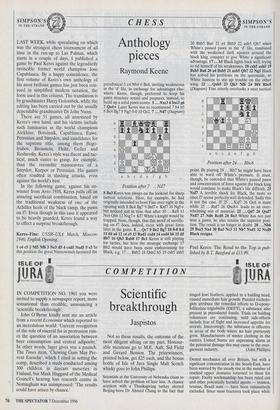SIMPSON'S
IN-THE-STRAND
SIMPSON'S
IN-THE-STRAND
CHESS
Anthology pieces
Raymond Keene
LAST WEEK, while speculating on which was the strongest chess tournament of all time in the run-up to Las Palmas, which starts in a couple of days, I published a game by Paul Keres against the legendarily invincible former world champion Jose Capablanca. By a happy coincidence, the first volume of Keres's own anthology of his most brilliant games has just been reis- sued in simplified modem notation, the form used in this column. The translation is by grandmaster Harry Golombek, while the editing has been carried out by the usually dependable grandmaster Dr John Nunn.
There are 51 games, all annotated by Keres's own hand, and his victims include such luminaries as the world champions Alekhine, Botvinnik, Capablanca, Euwe, Petrosian and Smyslov, and candidates for the supreme title, among them Bogo- Iyubov, Bronstein, Flohr, Geller and Reshevsky. Keres's style was fluent and tac- tical, much easier to grasp, for example, than the recondite manoeuvres of a Smyslov, Karpov or Petrosian. His games often resulted in slashing attacks, even against the world's best.
In the following game, against his co- winner from Avro 1938, Keres pulls off an amazing sacrificial combination, based on the traditional weakness of one of the Achilles heels of the black camp, the pawn on f7. Even though in this case it appeared to be heavily guarded, Keres found a way to effect a surprise breakthrough.
Keres—Fine: USSR—USA Match, Moscow 1946; English Opening.
1 c4 c5 2 Nf.3 Nf6 3 Nc3 d5 4 cxd5 Nxd5 5 e3 In this position the great Nimzowitsch favoured the paradoxical 5 e4 Nb4 6 Bc4, inviting weaknesses in the 'd' file, in exchange for advantages else- where. Keres, though, preferred to keep his pawn structure sound and prepares, instead, to build up a solid pawn centre. 5 ... Nxc3 6 bxc3 g6 7 Qa4+ Later Keres was to recommend 7 h4 h5
8 Bc4 Bg7 9 Ng5 0-0 10 Qc2. 7... Nd7 (Diagram) Position after 7. . . Nd7
8 Ba3 Keres was always on the lookout for sharp tactical solutions. Here, for example, he had originally intended to bowl Fine over right in the opening with 8 Bc4 Bg7 9 Bx17+ Kxf7 10 Ng5+ but noticed just in time that after 10 ... Ke8 11 Ne6 Qb6 12 Nxg7+ ICf7 White's knight would be trapped. Note, though, that this motif of sacrific- ing on 17 does, indeed, recur with great force later in the game. 8 ...Qc7 9 Be2 Bg7 10 0-0 0-0 11 d4 a6 12 c4 e5 13 Radl exd4 14 exd4 b6 15 d5 Bb7 16 Qb3 Rab8 17 Bc1 Keres is still playing for tactics, but here the strategic exchange 17 8b2 would have been most embarrassing for Black, e.g. 17 ... Bxb2 18 Qxb2 b5 19 ocb5 axb5
20 Bxb5 Ba6 21 a4 Bxb5 22 axb5 Qb7 when White's passed pawn in the 'd' file, combined with the weakened dark squares around the black king, conspire to give White a significant advantage. 17 ...b5 Black fights back well, trying to rid himself of his weaknesses. 18 cxb5 axb5 19 Bxb5 Ba6 20 a4 Bxb5 21 axb5 Qb7 22 Ng5 Black has solved his problems on the queenside, so White hastens to stir up trouble on the other wing. 22 ...Qxb5 23 Qh3 Nf6 24 Bf4 Rbc8 (Diagram) Fine utterly overlooks a neat tactical
point. By playing 24 ...Rb7 he might have been able to ward off White's pressure. It must, though, be conceded that White's passed pawn and concentration of force against the black king would continue to make Black's life difficult. 25 NxI7 A terrible shock for Black, the more so since fl seems perfectly well defended. Sadly this is not the case. If 25 ...Kxf7 26 Qe6 is mate
while 25 Rxf7 26 Qxc8+ leads to an over- whelming win of material. 25 ...Qd7 26 Qxd7 Nxd7 27 Nd6 Rcd8 28 Be3 White has not just won a pawn, he also retains the superior posi- tion. The result is no longer in doubt. 28 ...Nb6 29 Bxc5 Na4 30 Ba3 Nc3 31 Nb7 Nxdl 32 Nxd8 Black resigns.
Paul Keres: The Road to the Top is pub- lished by B. T. Batsford at £15.99.


















































































 Previous page
Previous page